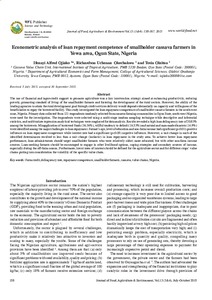| dc.contributor.author | Ojiako, I.A. |
| dc.contributor.author | Okechukwu, R.U. |
| dc.contributor.author | Olaitan, T. |
| dc.date.accessioned | 2019-12-04T11:03:39Z |
| dc.date.available | 2019-12-04T11:03:39Z |
| dc.date.issued | 2015 |
| dc.identifier.citation | Ojiako, I.A., Okechukwu, R. & Olaitan, T. (2015). Econometric analysis of loan repayment competence of smallholder cassava farmers in Yewa area, Ogun State, Nigeria. Journal of Good, Agriculture & Environment. 13(3&4), 158-167. |
| dc.identifier.issn | 1459-0255 |
| dc.identifier.uri | https://hdl.handle.net/20.500.12478/1177 |
| dc.description.abstract | The use of financial and input-credit support to promote agriculture was a key intervention strategy aimed at enhancing productivity, reducing poverty, promoting standard of living of the smallholder farmers and fostering the development of the rural sectors. However, the ability of the lending agencies to attain the rural development goal through credit services delivery would depend substantially on capacity and willingness of the beneficiaries to repay the borrowed facility. This study investigated the loan repayment competence of smallholder cassava farmers in the south-west zone, Nigeria. Primary data collected from 121 respondents randomly selected from cassava-farming communities in Ogun State, south-west Nigeria,
were used for the investigation. The respondents were selected using a multi-stage random sampling technique while descriptive and inferential statistics, and multivariate regression analytical techniques were employed for data analysis. Results revealed a high loan delinquency rate of 20.83% among the borrowers. Misapplication of borrowed funds (36.36%), willful tendency to default (16.53%) and natural and man-made disasters (14.9%) were identified among the major challenges to loan repayment. Farmer’s age, level of education and non-farm income had significant (p<0.01) positive influence on loan repayment competence while interest rate had a significant (p<0.05) negative influence. However, a unit change in each of the
identified determinants resulted to less than a unit change (inelastic) in loan repayment in the study area. To achieve better loan repayment performance, loan administrators should target smallholder farmers who were relatively older; more educated, but with other non-farm income sources. Loan-seeking farmers should be encouraged to engage in other livelihood options, coping strategies and secondary sources of income, especially during the off-farm season. Furthermore, lower rates of interest should be defined for the agriculture sector and for different crops’ value chains putting into consideration the volatility of the specific value chain. |
| dc.format.extent | 158-167 |
| dc.language.iso | en |
| dc.subject | Cassava |
| dc.subject | Value Chain |
| dc.title | Econometric analysis of loan repayment competence of smallholder cassava farmers in Yewa area, Ogun State, Nigeria |
| dc.type | Journal Article |
| dc.description.version | Peer Review |
| cg.contributor.crp | Roots, Tubers and Bananas |
| cg.contributor.affiliation | Olabisi Onabanjo University |
| cg.contributor.affiliation | International Institute of Tropical Agriculture |
| cg.coverage.region | Africa |
| cg.coverage.region | West Africa |
| cg.coverage.country | Nigeria |
| cg.authorship.types | CGIAR and developing country institute |
| cg.iitasubject | Cassava |
| cg.journal | Journal of Food, Agriculture & Environment |
| cg.howpublished | Formally Published |
| cg.accessibilitystatus | Limited Access |
| local.dspaceid | 78301 |
| cg.targetaudience | Scientists |

